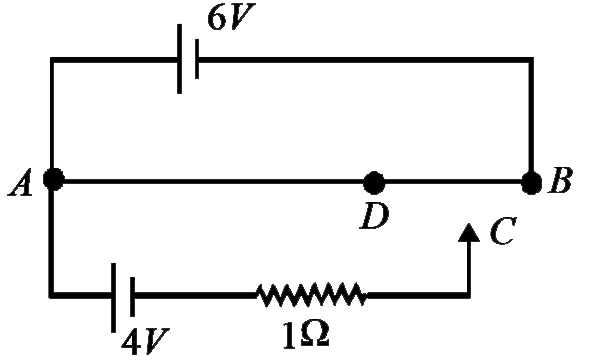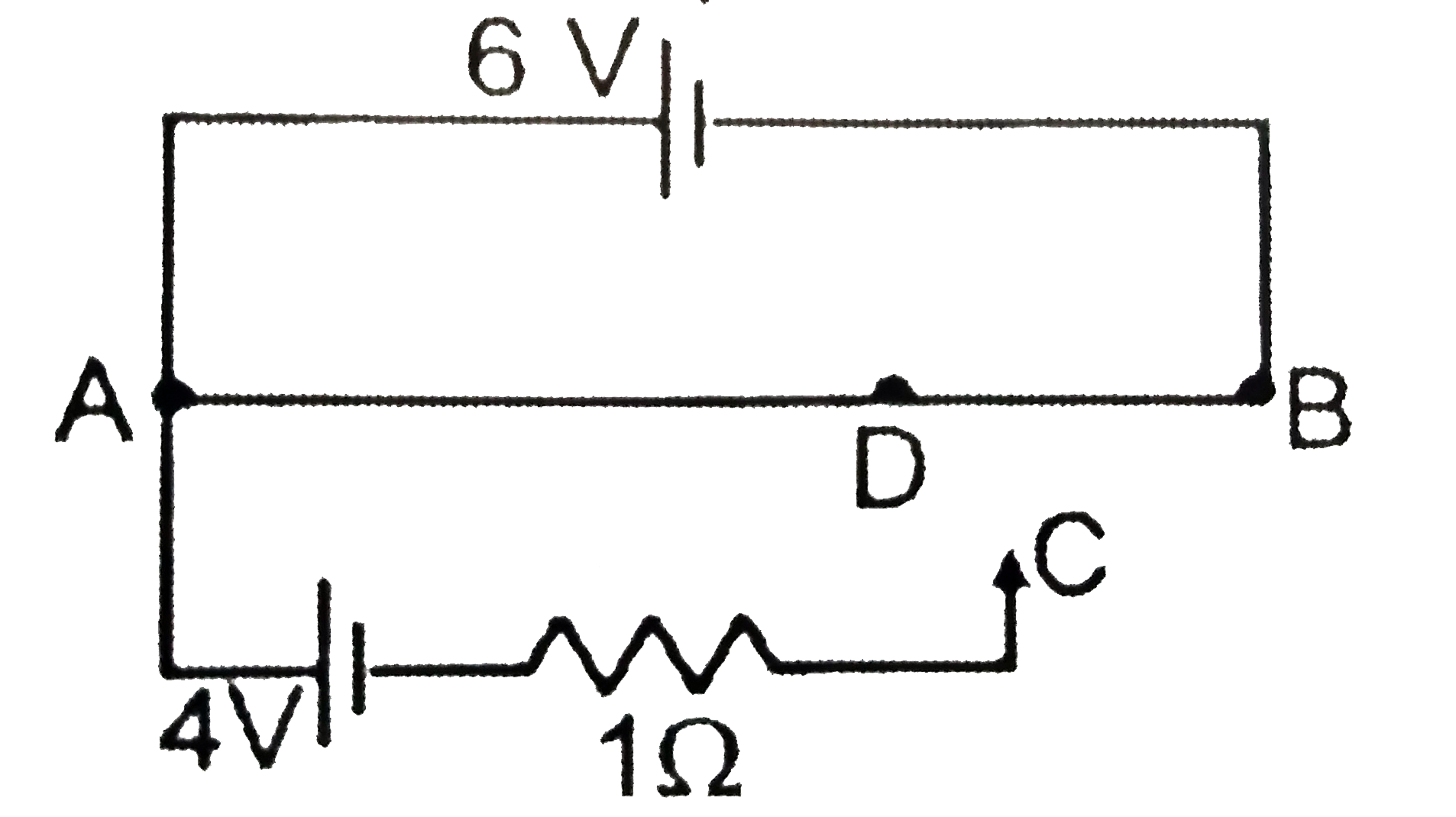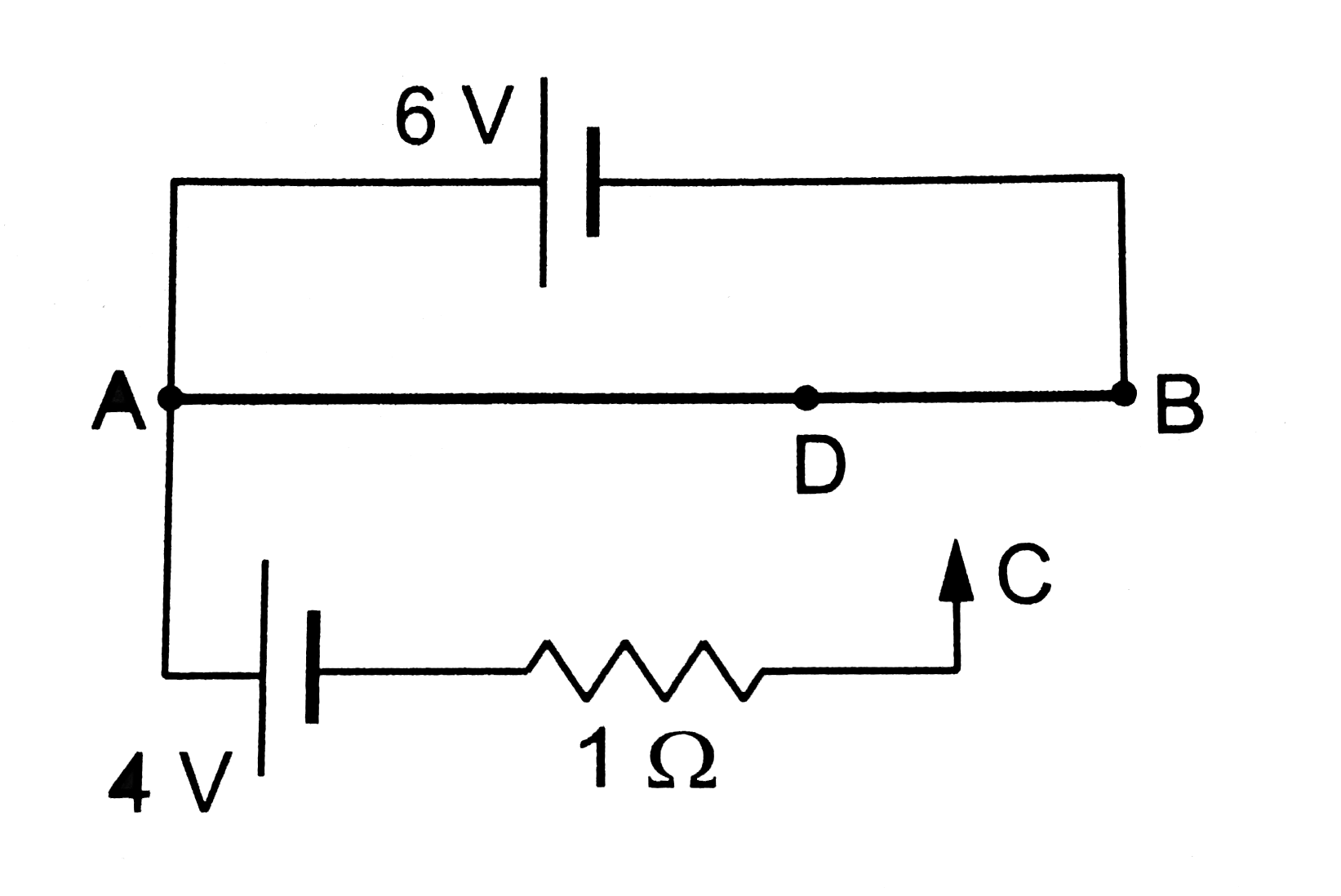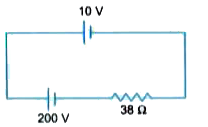A 6V battery of negligible internal resistance is connected across a uniform wire AB of length 100cm. The positive terminal of another battery of emf 4V and internal resistance 1Ω is joined to the point A as shown in figure. Take the potential at B to be zero.

2What are the potentials at points A and C ?
6V,2V
8V, 4 V
6V, 4V
8V, 3V
Step by step video & image solution for A 6V battery of negligible internal resistance is connected across a uniform wire AB of length 100cm. The positive terminal of another battery of emf 4V and internal resistance 1Omega is joined to the point A as shown in figure. Take the potential at B to be zero. 2What are the potentials at points A and C ? by Physics experts to help you in doubts & scoring excellent marks in Class 12 exams.
Updated on:21/07/2023Topper's Solved these Questions
Similar Questions
A 6 volt battery of negligible internal resistance is connected across a uniform wire AB of length 100cm. The positive terminal of another battery of emf 4V and internal resistance 1Ω is joind to the point A as shown in figure. Take the potential at B to be zero. (a) What are the potentials at the points A and C ? (b) At which D of the wire AB, the potential is equal to the potential at C. ( c) If the point C and D are connected by a wire. What will be the current through is ? (d) Id the 4V batteryt is replaced by 7.5 V battery, what whould be the answers of parts (a) and (b) ?

View SolutionA 6-volt battery of negligible internal resistance is connected across a uniform wire AB of length 100cm. The positive terminal of another battery of emf 4V and internal resistance 1(Ω)is joined to the point A as shown in figure.Take the potential at B to be zero. (a) What are the potentials at the poits A and C ? (b) At which point D of the wire AB, the potential is equal to the potential at C?(c ) If the point C and D are connected by a wire, what will be the current through it ? (d) If the 4V battery is replaced by 7.5V battery,wht would be the answer of parts (a) and (b) ?

View Solution
Knowledge Check
A 6V battery of negligible internal resistance is connected across a uniform wire of length 1m. The positive terminal of another battery of emf 4V and internal resistance 1Ω is joined to the point A as shown in figure. The ammeter shows zero deflection when the jockey touches the wire at the point C. The AC is equal to
 A2/3mB1/3mC3/5mD1/2m
A2/3mB1/3mC3/5mD1/2mA battery of emf 2 V and initial resistance 1Ω is
connected across terminals A and B of the circuit shown
in figure
 . AThermal power generated in the external circuit will be maximum possible when R=16/25Ω.BMaximum possible thermal power generated in the external circuit is equal to 4 W.CRatio of current through 3Ω to that through 8Ω is independent of R.DNone of above.
. AThermal power generated in the external circuit will be maximum possible when R=16/25Ω.BMaximum possible thermal power generated in the external circuit is equal to 4 W.CRatio of current through 3Ω to that through 8Ω is independent of R.DNone of above.
A 6 volt battery of negligible internal resistance is connected across a uniform wire AB of length 100cm. The positive terminal of another battery of emf 4V and internal resistance 1Ω is joind to the point A as shown in figure. Take the potential at B to be zero. (a) What are the potentials at the points A and C ? (b) At which D of the wire AB, the potential is equal to the potential at C. ( c) If the point C and D are connected by a wire. What will be the current through is ? (d) Id the 4V batteryt is replaced by 7.5 V battery, what whould be the answers of parts (a) and (b) ?

View SolutionA 6V battery of negligible internal resistance is connected across a uniform wire of length 1m . The positive terminal of another battery of emf 4V and internal resistance 1Ω is joined to the point A as shown in figure . The ammenter shows zero deflection when the jockey touches the wire at the point C. The AC is equal to

View SolutionA 6V battery of internal resistance 1Ω is connected across a uniform wire AB of length 100 cm. The positive terminal of another battery of E.M.F 4V and internal resistance 1Ω is joined to the point A as shown. The distance of point P from A is α×10cm. Find the value of α, for which there is no current through the galvanometer. (resistance of AB wire is 5Ω)

View SolutionA battery of emf 2V and internal resistance 0.5(Ω)is connected across a resistance in 1 second?
View SolutionA 10 V cell of negligible internal resistance is connected in parallel across a battery of emf 200 V and internal resistance 38 Ω as shown in the Fig. Find the value of current in the circuit.

View SolutionA 5 V battery of negligible internal resistance is connected across a 200 V battery and a resistance of 39Ω as shown in the figure. Find the value of the current.

View Solution